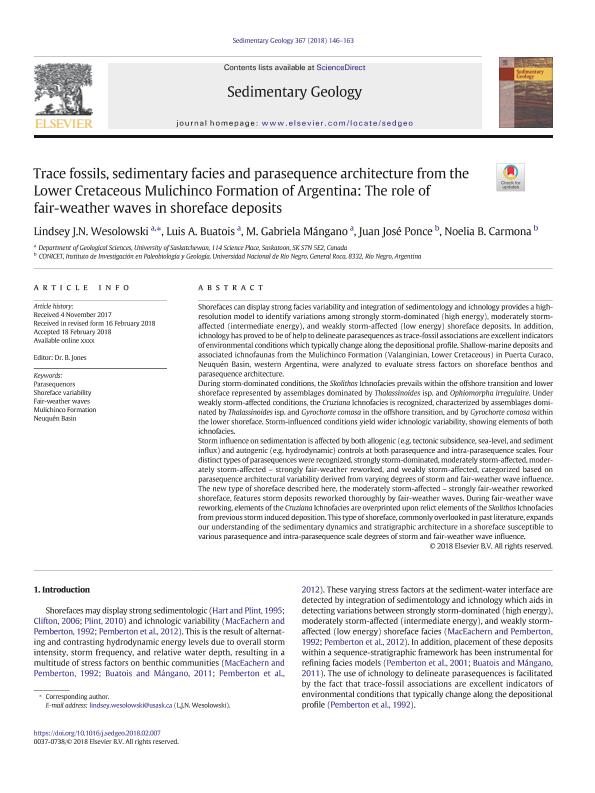Mostrar el registro sencillo del ítem
dc.contributor.author
Wesolowski, Lindsey J.N.
dc.contributor.author
Buatois, Luis Alberto

dc.contributor.author
Mangano, Maria Gabriela

dc.contributor.author
Ponce, Juan Jose

dc.contributor.author
Carmona, Noelia Beatriz

dc.date.available
2019-11-09T00:02:30Z
dc.date.issued
2018-05
dc.identifier.citation
Wesolowski, Lindsey J.N.; Buatois, Luis Alberto; Mangano, Maria Gabriela; Ponce, Juan Jose; Carmona, Noelia Beatriz; Trace fossils, sedimentary facies and parasequence architecture from the Lower Cretaceous Mulichinco Formation of Argentina: The role of fair-weather waves in shoreface deposits; Elsevier Science; Sedimentary Geology; 367; 5-2018; 146-163
dc.identifier.issn
0037-0738
dc.identifier.uri
http://hdl.handle.net/11336/88402
dc.description.abstract
Shorefaces can display strong facies variability and integration of sedimentology and ichnology provides a high-resolution model to identify variations among strongly storm-dominated (high energy), moderately storm-affected (intermediate energy), and weakly storm-affected (low energy) shoreface deposits. In addition, ichnology has proved to be of help to delineate parasequences as trace-fossil associations are excellent indicators of environmental conditions which typically change along the depositional profile. Shallow-marine deposits and associated ichnofaunas from the Mulichinco Formation (Valanginian, Lower Cretaceous) in Puerta Curaco, Neuquén Basin, western Argentina, were analyzed to evaluate stress factors on shoreface benthos and parasequence architecture. During storm-dominated conditions, the Skolithos Ichnofacies prevails within the offshore transition and lower shoreface represented by assemblages dominated by Thalassinoides isp. and Ophiomorpha irregulaire. Under weakly storm-affected conditions, the Cruziana Ichnofacies is recognized, characterized by assemblages dominated by Thalassinoides isp. and Gyrochorte comosa in the offshore transition, and by Gyrochorte comosa within the lower shoreface. Storm-influenced conditions yield wider ichnologic variability, showing elements of both ichnofacies. Storm influence on sedimentation is affected by both allogenic (e.g. tectonic subsidence, sea-level, and sediment influx) and autogenic (e.g. hydrodynamic) controls at both parasequence and intra-parasequence scales. Four distinct types of parasequences were recognized, strongly storm-dominated, moderately storm-affected, moderately storm-affected – strongly fair-weather reworked, and weakly storm-affected, categorized based on parasequence architectural variability derived from varying degrees of storm and fair-weather wave influence. The new type of shoreface described here, the moderately storm-affected – strongly fair-weather reworked shoreface, features storm deposits reworked thoroughly by fair-weather waves. During fair-weather wave reworking, elements of the Cruziana Ichnofacies are overprinted upon relict elements of the Skolithos Ichnofacies from previous storm induced deposition. This type of shoreface, commonly overlooked in past literature, expands our understanding of the sedimentary dynamics and stratigraphic architecture in a shoreface susceptible to various parasequence and intra-parasequence scale degrees of storm and fair-weather wave influence.
dc.format
application/pdf
dc.language.iso
eng
dc.publisher
Elsevier Science

dc.rights
info:eu-repo/semantics/openAccess
dc.rights.uri
https://creativecommons.org/licenses/by-nc-sa/2.5/ar/
dc.subject
FAIR-WEATHER WAVES
dc.subject
MULICHINCO FORMATION
dc.subject
NEUQUÉN BASIN
dc.subject
PARASEQUENCES
dc.subject
SHOREFACE VARIABILITY
dc.subject.classification
Geología

dc.subject.classification
Ciencias de la Tierra y relacionadas con el Medio Ambiente

dc.subject.classification
CIENCIAS NATURALES Y EXACTAS

dc.title
Trace fossils, sedimentary facies and parasequence architecture from the Lower Cretaceous Mulichinco Formation of Argentina: The role of fair-weather waves in shoreface deposits
dc.type
info:eu-repo/semantics/article
dc.type
info:ar-repo/semantics/artículo
dc.type
info:eu-repo/semantics/publishedVersion
dc.date.updated
2019-08-08T19:10:44Z
dc.journal.volume
367
dc.journal.pagination
146-163
dc.journal.pais
Países Bajos

dc.journal.ciudad
Amsterdam
dc.description.fil
Fil: Wesolowski, Lindsey J.N.. University of Saskatchewan; Canadá
dc.description.fil
Fil: Buatois, Luis Alberto. Consejo Nacional de Investigaciones Científicas y Técnicas; Argentina. University of Saskatchewan; Canadá
dc.description.fil
Fil: Mangano, Maria Gabriela. Consejo Nacional de Investigaciones Científicas y Técnicas; Argentina. University of Saskatchewan; Canadá
dc.description.fil
Fil: Ponce, Juan Jose. Consejo Nacional de Investigaciones Científicas y Técnicas. Centro Científico Tecnológico Conicet - Patagonia Norte. Instituto de Investigación en Paleobiología y Geología; Argentina
dc.description.fil
Fil: Carmona, Noelia Beatriz. Consejo Nacional de Investigaciones Científicas y Técnicas. Centro Científico Tecnológico Conicet - Patagonia Norte. Instituto de Investigación en Paleobiología y Geología; Argentina
dc.journal.title
Sedimentary Geology

dc.relation.alternativeid
info:eu-repo/semantics/altIdentifier/doi/https://doi.org/10.1016/j.sedgeo.2018.02.007
dc.relation.alternativeid
info:eu-repo/semantics/altIdentifier/url/https://www.sciencedirect.com/science/article/pii/S0037073818300319
Archivos asociados
